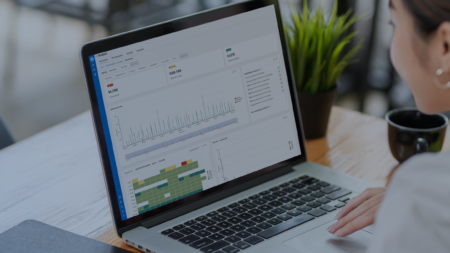Internal control checklists have long been a cornerstone of governance and compliance—guiding organizations through key processes, policies, and risk areas. But in a world where the volume of data, regulatory pressure, and financial complexity have exploded, the traditional checklist is no longer enough. It’s time to evolve your internal control framework from static oversight to dynamic, data-driven assurance.
Whether you’re supporting Sarbanes-Oxley (SOX), UK SOX, or broader financial reporting objectives, this post walks through the key components of an effective internal control checklist—while showing how leading organizations are moving from reactive checklists to AI-powered continuous control monitoring with MindBridge.
Why Internal Controls Still Matter—But Need to Be Smarter
Internal controls are designed to protect the integrity of financial data, support compliance, and prevent errors or fraud. A well-structured checklist helps you:
- Safeguard assets with proper segregation of duties and oversight
- Ensure accuracy of financial statements
- Maintain regulatory compliance across jurisdictions
- Improve operational efficiency by embedding controls into core processes
But here’s the catch: most organizations still rely on manual, sample-based, or checklist-driven controls—which often miss critical issues, delay risk identification, and consume valuable time from finance and audit teams.
The Traditional Control Checklist: What’s Covered
An effective internal control checklist should align with the COSO Integrated Framework, which includes five key components that form the foundation of any modern control environment:
Control Environment
This sets the tone for organizational integrity and accountability. It includes formal codes of conduct, leadership commitment to oversight, defined risk tolerance, and documented reporting lines. Organizations should ensure that whistleblower channels, ethics training, and board-level review of controls are in place.
Risk Assessment
Strong checklists begin by identifying and evaluating risks to achieving objectives. Practical tools include dynamic risk matrices, scenario-based fraud assessments, and documented risk tolerances. This ensures that both known risks and emerging threats are factored into the control strategy.
Control Activities
These are the policies and procedures that help mitigate risk. Examples include cross-checking invoices against purchase orders, implementing system access controls, and enforcing segregation of duties—especially in areas like procurement and journal entry posting. Automated exception reviews can also reduce human error and flag unusual activity.
Information & Communication
Internal controls require high-quality data and effective communication flows. This means role-based access controls, standardized reporting structures, automated data feeds from ERP systems, and clear channels for internal escalation and approvals.
Monitoring Activities
Monitoring is not a one-off—it’s an ongoing discipline. Best practices include automated reconciliation testing, tracking control deficiencies through centralized systems, and continuous anomaly detection dashboards that alert control owners to risk in real time.
Checklists provide structure—but too often, they stop at compliance rather than driving insight or action. They rarely prioritize which controls matter most today. And they certainly don’t scale with your business.
The Limitations of Manual Internal Controls
Control owners and finance teams know the reality:
- Repetitive reviews of the same reports every month
- Sampling instead of full visibility into transactional risk
- Time wasted chasing data or validating control execution
- Little to no insight into the “unknown unknowns” that cause issues later
You’re stuck firefighting when you should be leading. The checklist may tick the box—but it won’t warn you when controls are failing or uncover emerging risks across millions of transactions.
What Leading Organizations Are Doing Instead
Modern finance leaders are rethinking internal controls altogether. With the MindBridge AI™ platform, they’re embedding AI-powered anomaly detection and continuous monitoring directly into their financial workflows.
MindBridge strengthens your internal controls framework by analyzing 100% of transactions across the general ledger, sub-ledgers, and key business processes. It assigns a risk score to every entry based on a combination of rule-based tests, statistical models, and unsupervised machine learning.
Here’s what that unlocks:
- Proactive Risk Detection
Surface hidden risks in journal entries, vendor invoices, payroll, and more—before they escalate.
- Continuous Monitoring, Not Periodic Checks
Move from checklist-driven sampling to full-population analysis and anomaly detection.
- Explainable AI for Control Owners
Understand why something was flagged—and act with confidence.
- Audit-Ready Transparency
Provide a clear audit trail and evidence of monitoring, without extra work.
- Scalable Efficiency
Free your team from repetitive reviews and focus their time on high-value tasks.
Automating Internal Controls with MindBridge: COSO-Aligned
Here’s how MindBridge maps directly to the five COSO components, upgrading your checklist with intelligent automation:
- Control Environment
Embed AI into your ICFR strategy to set a “data-first” tone from the top and promote accountability with transparent anomaly detection across all transactions.
- Risk Assessment
Quantify and segment financial risk at the transaction level. Use full-population risk scoring to prioritize control resources dynamically.
- Control Activities
Replace manual detective controls with machine learning that adapts to your data. Identify outliers and high-risk transactions automatically.
- Information & Communication
Leverage APIs to integrate risk scoring into your ERP and GRC tools. Standardize reporting across functions and regions.
- Monitoring Activities
Conduct ongoing evaluations with risk segmentation, analytic annotations, and automated evidence capture—built for internal and external assurance.
Learn more in our AiCFR™ whitepaper →
How to Evolve Your Internal Controls Framework: A Maturity Path
Modernizing your internal controls isn’t a binary flip—it’s a scalable, iterative journey. Most organizations begin by strengthening one control area (e.g., GL), then progressively scale to more datasets and processes.
A typical evolution looks like this:
- Checklist-Driven Compliance
Teams manually track risks and controls using spreadsheets or GRC systems—adequate for documentation, but not detection.
- Standardized Control Testing
Controls are documented and tested periodically, often via sample-based reviews that leave significant blind spots.
- Transaction-Level Risk Scoring
AI is used to analyze 100% of transactions and assign risk scores to entries—enhancing coverage and uncovering process anomalies.
- Continuous Monitoring and AI-Driven Assurance
Controls shift from reactive to proactive, with continuous monitoring embedded into daily workflows and strategic oversight.
Whether you’re at stage 1 or 3, MindBridge helps you scale intelligently—without disrupting what’s already working.
For organizations operating at scale, our enterprise solution offers the depth, flexibility, and control required to embed continuous monitoring across complex financial systems and processes.
How Polaris Modernized Internal Controls with AI-Powered Risk Insights
Polaris, a global leader in powersports, transformed its internal control environment by embedding MindBridge into its finance workflows. Faced with the challenges of growing complexity and limited audit capacity, Polaris needed more than a checklist—it needed clarity.
By leveraging MindBridge’s AI-powered risk scoring, Polaris was able to:
- Reduce sample sizes by focusing on 100% population analysis
- Pinpoint high-risk transactions across general ledger, vendor, and payroll data sets
- Shift from reactive testing to proactive control monitoring tied to actual risk
“Instead of doing a little bit of everything, we now focus on the areas of highest risk.”
— Chris Swanson, Polaris
Their team now uses MindBridge not just to test controls but also to continuously assess them, prioritize reviews, and allocate resources based on risk—not guesswork.
Explore the Polaris case study →
Still Using a Traditional Internal Control Checklist? Here’s Your Next Step
You don’t have to rip and replace everything to modernize your internal controls. Most organizations begin their journey with general ledger analysis—scoring journal entries, validating completeness, and surfacing anomalies.
From there, you can expand into sub-ledgers, automate evidence capture, and build out full COSO-aligned monitoring—all without hiring more staff or overhauling your tech stack.
Then book a demo to see how MindBridge elevates it →
Final Thoughts: Elevate Your Checklist. Elevate Your Oversight.
The traditional internal control checklist helped get finance to where it is today—but it won’t get you where you need to go next. Regulatory scrutiny is growing. Data is compounding. And control failures carry real consequences.
MindBridge is the AI-powered decision intelligence platform built for this moment. It doesn’t just check the box. It gives you continuous, explainable insight into what’s happening, what’s at risk, and what to do next.
Let’s build controls that actually control. Let’s build smarter oversight.
Ready to start your AiCFR™ journey?
Book a demo and discover how MindBridge transforms your checklist into strategic financial intelligence.
FAQ Section: Internal Control Checklist
What is an internal control checklist, and why does it matter today?
An internal control checklist is a structured tool used to evaluate whether key controls—such as segregation of duties, financial reporting safeguards, and compliance procedures—are operating effectively. In today’s fast-changing risk landscape, it provides a foundation for control assurance. But leading organizations are going further—augmenting static checklists with AI-powered monitoring for real-time visibility and stronger risk management.
How often should an internal control checklist be reviewed or updated?
At a minimum, annually. But high-performing teams treat it as a living document—updating it proactively when risks evolve, regulations change, or systems are modified. If your checklist is still reviewed once a year, it’s likely outdated the moment it’s finalized.
Who is responsible for maintaining an internal control checklist?
Typically, finance leaders, internal audit, and compliance officers oversee the checklist. But that’s shifting. With modern AI tools like MindBridge, control visibility becomes more democratized—empowering individual control owners with transaction-level insights and shared accountability.
What should be included in an effective internal control checklist?
It should align with the COSO Internal Control-Integrated Framework and cover five essential components:
- Control Environment – Ethics, tone from the top, structure, accountability
- Risk Assessment – Risk identification, fraud analysis, tolerance thresholds
- Control Activities – Approvals, reconciliations, purchase order validation, segregation of duties
- Information & Communication – Access controls, reporting flows, escalation paths
- Monitoring Activities – Periodic testing, continuous monitoring, anomaly detection
A strong checklist sets the baseline, but pairing it with intelligent automation elevates assurance from static to strategic.
How does an internal control checklist help identify risk?
By standardizing how processes are assessed, a checklist uncovers gaps in control design or execution. When enhanced by AI, like MindBridge’s full-population risk scoring, it shifts from passive review to active detection—flagging control failures, anomalies, and fraud indicators early, before they become material problems.
Resources to Explore Next
- 📘 Download the AiCFR™ Whitepaper – Deep dive into control modernization with anomaly detection
- 📺 Watch the AiCFR™ Webinar – Real-world use cases from finance and audit leaders
- 📊 Explore Data Analytics in Internal Audit – How AI transforms internal audit and controls
- 🏢 See How Polaris Embedded AI in Internal Controls – Full case study



